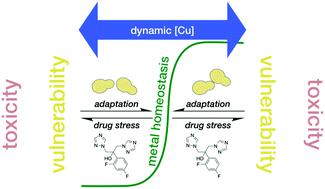当前位置:
X-MOL 学术
›
Metallomics
›
论文详情
Our official English website, www.x-mol.net, welcomes your
feedback! (Note: you will need to create a separate account there.)
Candida albicans reprioritizes metal handling during fluconazole stress.
Metallomics ( IF 2.9 ) Pub Date : 2019-11-04 , DOI: 10.1039/c9mt00228f Elizabeth W Hunsaker 1 , Katherine J Franz
Metallomics ( IF 2.9 ) Pub Date : 2019-11-04 , DOI: 10.1039/c9mt00228f Elizabeth W Hunsaker 1 , Katherine J Franz
Affiliation

|
Maintenance of metal homeostasis is critical to cell survival due to the multitude of cellular processes that depend on one or more metal cofactors. Here, we show that the opportunistic fungal pathogen Candida albicans extensively remodels its metal homeostasis networks to respond to treatment with the antifungal drug fluconazole. Disruption of the ergosterol biosynthetic pathway by fluconazole requires C. albicans adaptation, including increased Cu import and storage, increased retention of Fe, Mn, and Zn, altered utilization of Cu- and Mn-dependent enzymes, mobilization of Fe stores, and increased production of the heme prosthetic group utilized by the enzyme target of fluconazole. The findings offer a new perspective for thinking about fungal response to drug stress that pushes cells out of their metal homeostatic zones, leading them to enact metal-associated adaptation mechanisms to restore homeostasis to survive.
中文翻译:

白色念珠菌在氟康唑胁迫期间优先考虑金属处理。
由于许多依赖一种或多种金属辅助因子的细胞过程,金属稳态的维持对于细胞存活至关重要。在这里,我们表明机会性真菌病原体白色念珠菌广泛地重塑其金属稳态网络,以响应使用抗真菌药氟康唑的治疗。氟康唑破坏麦角固醇生物合成途径需要白色念珠菌适应,包括增加铜的进口和储存,增加铁,锰和锌的保留,改变依赖铜和锰的酶的利用率,动员铁的存储量以及增加氟康唑酶靶标利用的血红素辅基的产量。这些发现为思考真菌对药物应激的反应提供了新的视角,这种反应将细胞推离其金属稳态区域,从而促使它们制定金属相关的适应机制,以恢复体内的稳态。
更新日期:2019-11-04
中文翻译:

白色念珠菌在氟康唑胁迫期间优先考虑金属处理。
由于许多依赖一种或多种金属辅助因子的细胞过程,金属稳态的维持对于细胞存活至关重要。在这里,我们表明机会性真菌病原体白色念珠菌广泛地重塑其金属稳态网络,以响应使用抗真菌药氟康唑的治疗。氟康唑破坏麦角固醇生物合成途径需要白色念珠菌适应,包括增加铜的进口和储存,增加铁,锰和锌的保留,改变依赖铜和锰的酶的利用率,动员铁的存储量以及增加氟康唑酶靶标利用的血红素辅基的产量。这些发现为思考真菌对药物应激的反应提供了新的视角,这种反应将细胞推离其金属稳态区域,从而促使它们制定金属相关的适应机制,以恢复体内的稳态。











































 京公网安备 11010802027423号
京公网安备 11010802027423号